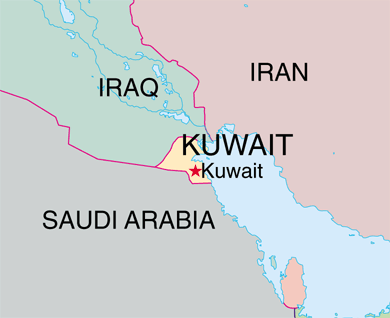

The Gulf War (also known as The Persian War) was caused by Iraq’s invasion of its neighbouring country Kuwait on August 2nd 1990. Saddam Hussein, leader of Iraq, wanted to take Kuwait’s large oil reserves as part of what he thought was owed to him and to make Iraq more powerful in the Middle East region.
The rest of the world, through the United Nations (UN), responded by telling Saddam Hussein to get out of Kuwait and imposing a word-wide ban on trade with Iraq. Iraq did not respond as the UN had hoped and formally took over Kuwait on August 8th.
The international community were also worried about the potential threat to Saudi Arabia, the country that was to the south of Kuwait and at that time the worlds largest producer of oil. As talks continued the United States and other European Countries, including the United Kingdom, sent troops to Saudi Arabia. This was known as Operation Desert Shield.
A coalition (group) began to form as a military option (to remove Iraq by force) developed.
On 29th November, Iraq was given an ultimatum by the UN – withdraw by January 15th 1991 or the use of force would be allowed. Saddam Hussein did not make a move and the deadline passed.
On January 16/17 1991 planning turned into action as the military campaign (war) started.
It began with an air campaign called Operation Desert Storm. The aim was to destroy Iraq’s own air defences, weapons plants, oil refineries and supply routes by bombing key bridges and roads. They then moved on to tanks and camps in southern Iraq and Kuwait.
By mid-February, the allies (the coalition against Iraq) had moved to attacking on land. Operation Desert Sabre was a massive ground offensive launched from Saudi Arabia. Within three days the allies had retaken the capital of Kuwait, Kuwait City. By 27th February most of Iraq’s Republican Guard had been destroyed and sensing the war was over President Bush called a ceasefire.
There are estimates that the number of Iraqi troops involved in the Gulf War ranged from 180,000 to 630,000. Estimates on the number of Iraqi military deaths range from 8,000 to 100,000. The allies, by contrast, lost about 300 troops in the conflict of which 47 were British.
Iraq was forced to recognize Kuwait’s sovereignty (it was a country in its own right) and that it had to get rid of all weapons of mass destruction (i.e., nuclear, biological, and chemical weapons) and all missiles with ranges exceeding 90 miles (150 km). Economic sanctions would continue until this happened.
Following Iraq’s defeat in the Gulf War, a group known as Kurds in the north of the country and Shīʿites in the south started a rebellion. Saddam Hussein responded with great brutality. The allies had to create no-fly zones over these areas and U.S and British aircraft patrolled the skies.
In the meantime, UN inspectors tried to make sure that all the weapons were being destroyed. Saddam Hussein did not make this easy. The result was a bombing campaign in 1998 known as Operation Desert Fox by the allies. After several years of tension, and post-9/11, a new resolution was put to the UN sponsored by the United States, now under President George W. Bush, and weapons inspectors returned. However, arguments began amongst the members of the UN Security Council about how much Iraq was complying with getting rid of its weapons.
On March 17, 2003, the United States and the United Kingdom, which had begun to mass troops on Iraq’s border, stopped any more negotiations, and the U.S, acting without the UN told Saddam to step down from power and leave Iraq within 48 hours or face war. He refused to leave and U.S. and allied forces launched an attack on Iraq on March 20. This started the Iraq War.
